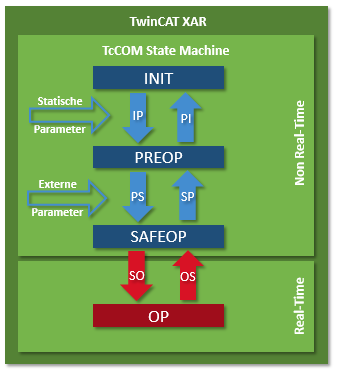TwinCAT module state machine
In addition to the states (INIT, PREOP, SAFEOP and OP), there are corresponding state transitions, within which general or module-specific actions have to be executed or can be executed. The design of the state machine is very simple. In any case, there are only transitions to the next or previous step.
This results in the state transitions: INIT to PREOP (IP), PREOP to SAFEOP (PS) and SAFEOP to OP (SO). In the opposite direction, the following state transitions exist: OP to SAFEOP (OS), SAFEOP to PREOP (SP) and PREOP to INIT (PI). Up to and including the SAFEOP state, all states and state transitions take place within the non-real-time context. Only the transition from SAFEOP to OP, the OP state and the transition from OP to SAFEOP take place in the real-time context. This differentiation is relevant when resources are allocated or enabled, or when modules register or deregister with other modules.

State: INIT
The INIT state is only a virtual state. Immediately after creation of a module, the module changes from INIT to PREOP, i.e. the IP state transition is executed. The instantiation and the IP state transition always take place together, so that the module never remains in INIT state. Only when the module is removed does it remain in INIT state for a short time.
Transition: INIT to PREOP (IP)
During the IP state transition, the module registers with the ObjectServer with its unique ObjectID. The initialization parameters, which are also allocated during object creation, are transferred to the module. During this transition the module cannot establish connections to other modules, because it is not clear whether the other modules already exist and are registered with the ObjectServer. When the module requires system resources (e.g. memory), these can be allocated during the state transition. All allocated resources have to be released again during the transition from PREOP to INIT (PI).
State: PREOP
In PREOP state, module creation is complete and the module is usually fully parameterized, even if further parameters may be added during the transition from PREOP to SAFEOP. The module is registered in the ObjectServer, although no connections with other modules have been created yet.
Transition: PREOP to SAFEOP (PS)
In this state transition the module can establish connections with other modules. To this end it has usually received, among other things, ObjectIDs of other modules with the initialization data, which are now converted to actual connections with these modules via the ObjectServer.
The transition can generally be triggered by the system according to the configurator, or by another module (e.g. the parent module). During this state transition further parameters can be transferred. For example, the parent module can transfer its own parameters to the child module.
State: SAFEOP
The module is still in the non-real-time context and is waiting to be switched to OP state by the system or by other modules.
Transition: SAFEOP to OP (SO)
The state transition from SAFEOP to OP, the state OP, and the transition from OP to SAFEOP take place in the real-time context. System resources may no longer be allocated. On the other hand, resources can now be requested by other modules, and modules can register with other modules, e.g. in order to obtain a cyclic call during tasks.
This transition should not be used for long-running tasks. For example, file operations should be executed during PS.
State: OP
In OP state the module starts working and is fully active in the meaning of the TwinCAT system.
Transition: OP to SAFEOP (OS)
This state transition takes place in the real-time context. All actions from the SO transition are reversed, and all resources requested during the SO transition are released again.
Transition: SAFEOP to PREOP (SP)
All actions from the PS transition are reversed, and all resources requested during the PS transition are released again.
Transition: PREOP to INIT (PI)
All actions from the IP transition are reversed, and all resources requested during the IP transition are released again. The module signs off from the ObjectServer and usually deletes itself (see "Service life").